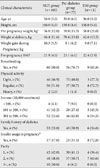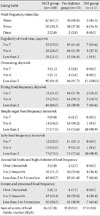1. The Expert Committee on the Diagnosis and Classification of Diabetes Mellitus. Report of the Expert Committee on the Diagnosis and Classification of Diabetes Mellitus. Diabetes Care. 2002. 25:Suppl 1. S5–S20.
2. Moses RG, Cheung NW. Point: universal screening for gestational diabetes mellitus. Diabetes Care. 2009. 32:1349–1351.
3. American Diabetes Association. Gestational diabetes mellitus. Diabetes Care. 2004. 27:Suppl 1. S88–S90.
4. Dabelea D, Snell-Bergeon JK, Hartsfield CL, Bischoff KJ, Hamman RF, McDuffie RS. Kaiser Permanente of Colorado GDM Screening Program. Increasing prevalence of gestational diabetes mellitus (GDM) over time and by birth cohort: Kaiser Permanente of Colorado GDM Screening Program. Diabetes Care. 2005. 28:579–584.
5. Jang HC, Jung KB, Cho NH, Metzger BE. Gestational diabetes mellitus in Korea: is universal screening necessary? Korean J Obstet Gynecol. 1996. 39:519–530.
6. Jang HC, Cho YM, Park KS, Kim SY, Lee HK, Kim MY, Yang JH, Shin SM. Pregnancy outcome in Korean women with gestational diabetes mellitus diagnosed by the Carpenter-Coustan criteria. J Korean Diabetes Assoc. 2004. 28:122–130.
7. Setji TL, Brown AJ, Feinglos MN. Gestational diabetes mellitus. Clin Diabetes. 2005. 23:17–24.
8. Kim C, Newton KM, Knopp RH. Gestational diabetes and the incidence of type 2 diabetes: a systematic review. Diabetes Care. 2002. 25:1862–1868.
9. Park SK, Park MK, Suk JH, Kim MK, Kim YK, Kim IJ, Kang YH, Lee KJ, Lee HS, Lee CW, Kim BH, Lee KI, Kim MK, Kim DK. Cause-of-death trends for diabetes mellitus over 10 years. Korean Diabetes J. 2009. 33:65–72.
10. Hu J, Norman M, Wallensteen M, Gennser G. Increased large arterial stiffness and impaired acetylcholine induced skin vasodilatation in women with previous gestational diabetes mellitus. Br J Obstet Gynaecol. 1998. 105:1279–1287.
11. Jang HC. High risk group of type II DM: gestational diabetes mellitus. J Korean Diabetes Assoc. 2005. 29:11–17.
12. Yu SY, Hong HS, Lee HS, Choi YJ, Huh KB, Kim WY. The association of insulin resistance with cardiovascular disease risk and dietary factors in Korean type 2 DM patients. Korean J Nutr. 2007. 40:31–40.
13. Dandona P, Aljada A, Chaudhuri A, Mohanty P, Garg R. Metabolic syndrome: a comprehensive perspective based on interactions between obesity, diabetes, and inflammation. Circulation. 2005. 111:1448–1454.
14. Ji SK, Jang HC, Choi H. A case-control study of food habits and diet intakes of women with gestational diabetes mellitus. Korean J Nutr. 2008. 41:41–53.
15. Park BK. The effects of carbohydrate-restricted diet therapy in gestational diabetes [master's thesis]. 2001. [Seoul]: Yonsei University.
16. American Diabetes Association. Diagnosis and classification of diabetes mellitus. Diabetes Care. 2008. 31:Suppl 1. S55–S60.
17. The Korean Nutrition Society. Dietary reference intakes for Koreans. 2005. Seoul: The Korean Nutrition Society;22.
18. The Korean Dietetic Association. Manual of medical nutrition therapy. 2008. 3rd ed. Seoul: The Korean Dietetic Association;18. 39.
19. American Association of Diabetes Educators. A core curriculum for diabetes education. 2003. 5th ed. Chicago: American Association of Diabetes Educators;3–58.
20. Jang HC, Yim CH, Han KO, Yoon HK, Han IK, Kim MY, Yang JH, Cho NH. Gestational diabetes mellitus in Korea: prevalence and prediction of glucose intolerance at early postpartum. Diabetes Res Clin Pract. 2003. 61:117–124.
21. Rivas AM, Gonzalez N, Gonzalez J. High frequency of diabetes in early post-partum assessment of women with gestational diabetes mellitus. Diabetes Metab Syndr. 2007. 1:159–165.
22. Yang EJ, Kim WY. The influence of dietary factors on the incidence of non-insulin dependent diabetes mellitus. Korean J Nutr. 1999. 32:407–418.
23. Gonzalez-Clemente JM, Carro O, Gallach I, Vioque J, Humanes A, Sauret C, Abella M, Gimenez-Perez G, Mauricio D. Increased cholesterol intake in women with gestational diabetes mellitus. Diabetes Metab. 2007. 33:25–29.
24. Lau DC. Dietary cholesterol and other nutritional considerations in people with diabetes. Int J Clin Pract Suppl. 2009. (163):15–21. 44–51.
25. Thanopoulou AC, Karamanos BG, Angelico FV, Assaad-Khalil SH, Barbato AF, Del Ben MP, Djordjevic PB, Dimitrijevic-Sreckovic VS, Gallotti CA, Katsilambros NL, Migdalis IN, Mrabet MM, Petkova MK, Roussi DP, Tenconi MT. Dietary fat intake as risk factor for the development of diabetes: multinational, multicenter study of the Mediterranean Group for the Study of Diabetes (MGSD). Diabetes Care. 2003. 26:302–307.
26. van Dam RM, Willett WC, Rimm EB, Stampfer MJ, Hu FB. Dietary fat and meat intake in relation to risk of type 2 diabetes in men. Diabetes Care. 2002. 25:417–424.
27. Sluijs I, Beulens JW, van der A DL, Spijkerman AM, Grobbee DE, van der Schouw YT. Dietary intake of total, animal, and vegetable protein and risk of type 2 diabetes in the European Prospective Investigation into Cancer and Nutrition (EPIC)-NL study. Diabetes Care. 2010. 33:43–48.
28. Zhang C, Schulze MB, Solomon CG, Hu FB. A prospective study of dietary patterns, meat intake and the risk of gestational diabetes mellitus. Diabetologia. 2006. 49:2604–2613.
29. Rajpathak S, Ma J, Manson J, Willett WC, Hu FB. Iron intake and the risk of type 2 diabetes in women: a prospective cohort study. Diabetes Care. 2006. 29:1370–1376.
30. Hwang MR, Shin MH, Rhee JA, Kweon SS, Lim HS. Effects of folic acid or ascorbate supplementation on plasma homocysteine levels and oxidative stress in Korean adults with impaired fasting glucose. Korean J Community Nutr. 2008. 13:263–275.
31. Kitzmiller JL, Dang-Kilduff L, Taslimi MM. Gestational diabetes after delivery. Short-term management and long-term risks. Diabetes Care. 2007. 30:Suppl 2. S225–S235.
32. Meyers-Seifer CH, Vohr BR. Lipid levels in former gestational diabetic mothers. Diabetes Care. 1996. 19:1351–1356.










 PDF
PDF ePub
ePub Citation
Citation Print
Print



 XML Download
XML Download